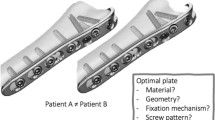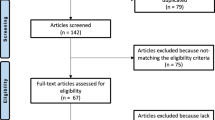Abstract
Background
Modularity in total hip arthroplasty has been used for decades with great success, but new findings regarding corrosion artifacts have caused a resurgence in tapered junction research. Mechanically assisted crevice corrosion (MACC) is thought to be the mechanism by which corrosive attack occurs. Myriad multi-factorial variables are known to influence the susceptibility of a modular taper junction to MACC. Some of these variables are design and manufacture related and others can be controlled by the surgeon.
Questions/Purposes
This study was performed to assess a 22-year retrieval database to determine if correlations exist between severity of corrosion artifacts and head size, time in vivo, head offset, or head material. Secondarily, the agreement of visual and semi-quantitative scoring methods was assessed using the retrieved components.
Methods
A total of 210 femoral head tapers were scored and heads receiving high scores were measured to quantify material loss due to MACC.
Results
Increased head size and increased time in vivo did not correlate to higher corrosion scores. Contrarily, there were differences in corrosion scores based on femoral head offset and material. Deviations away from a neutral offset (where neutral is defined as the alignment of femoral head center and stem taper gage point) resulted in higher scores. Cobalt-chromium-molybdenum heads were associated with higher corrosion scores and higher material loss as compared to oxidized zirconium heads.
Conclusion
Reducing the moment arm at the head-neck junction and choosing a more inert material appears to provide greater resistance to corrosion.







Similar content being viewed by others
References
Allen CL, Hooper GJ, Frampton CM. Do larger femoral heads improve the functional outcome in total hip arthroplasty? J Arthroplast. 2014; 29(2): 401-4.
Barrack R, Cook S, Lavernia C, Jani S, Tozakoglou E. The modular Morse taper junction in total hip replacement, Scientific Exhibit at AAOS Meeting, San Francisco; 1997.
Clarke IC, Manaka M, Green DD, et al. Current status of zirconia used in total hip implants. JSJBS-Am. 2003; 85-A(supp 4): 73-84.
Collier JP, Surprenant VA, Jenson RE, et al. Corrosion at the interface of cobalt-alloy heads on titanium-alloy stems. CORR. 1991; 271: 305-12.
Cook SD, Barrack RL, Baffes GC, et al. Wear and corrosion of modular interfaces in total hip replacements. CORR. 1994; 298: 80-88.
Cooper JH, Della Valle CJ, Berger RA, et al. Corrosion at the head-neck taper as a cause for adverse local tissue reactions after total hip arthroplasty. JCJS-Am. 2012; 94(18): 1655-61.
Dalal A, Pawar V, McAllister K, et al. Orthopedic implant cobalt-alloy particles produce greater toxicity and inflammatory cytokines than titanium alloy and zirconium alloy-based particles in vitro, in human osteoblasts, fibroblasts, and macrophages. JBMR-A. 2012; 100A(8): 2147-58.
Davis JR editor. Handbook of materials for medical devices. ASM International; 2003.
Dyrkacz RMR, Brandt JM, Ojo OA, et al. The influence of head size on corrosion and fretting behavior at the head-neck interface of artificial hip joints. J Arthroplast. 2013; 28(6): 1036-40.
Elpers M, Nam D, Boydston-White S, et al. Zirconia phase transformation, metal transfer, and surface roughness in retrieved ceramic composite femoral heads in total hip arthroplasty. J Arthroplast. 2014; 29(11): 2219-23.
Gilbert JL, Buckley CA, Jacobs JJ. In vivo corrosion of modular hip prosthesis components in mixed and similar metal combinations: the effect of crevice, stress, motion, and alloy coupling. JBMR. 1993; 27: 1533-44.
Goldberg JR, Gilbert JL, Jacobs JJ, et al. A multicenter retrieval study of the taper interfaces of modular hip prostheses. CORR. 2002; 401: 149-61.
Guhrs J, Krull A, Witt F, et al. The influence of stem taper re-use upon the failure load of ceramic heads. Med Eng Phys. 2015; 37: 545-52.
Haraguchi K, Sugano N, Nishii R, et al. Phase transformation of a zirconia ceramic head after total hip arthroplasty. JBJS-Br. 2001; 83-B(7): 996-1000.
Higgs GB, Hanzlik JA, MacDonald DW, et al. Is increased modularity associated with increased fretting and corrosion damage in metal-on-metal total hip arthroplasty devices? A retrieval study. J Arthroplast. 2013; 28(8 sup): 2-6.
Jacobs JJ, Cooper HJ, Urban RM, et al. What do we know about taper corrosion in total hip arthroplasty? J Arthroplast. 2014; 29(4): 668-9.
Kop AM, Swarts E. Corrosion of a hip stem with a modular neck taper junction: a retrieval study of 16 cases. J Arthroplast. 2009; 24(7): 1019-23.
Kostensalo I, Junnila M, Virolainen P, et al. Effect of femoral head size on risk of revision for dislocation after total hip arthroplasty: a population-based analysis of 42,379 primary procedures from the Finnish Arthroplasty Register. Acta Orthop. 2013; 84(4): 342-7.
Kurtz SM, Kocagoz SB, Hanzlik JA, et al. Do ceramic femoral heads reduce taper fretting corrosion in hip arthroplasty? A retrieval study. CORR. 2013; 471: 3270-82.
Kurtz SM, MacDonald D, Higgs GB, et al. Are 36+ MM diameter HXLPE bearings at risk of increased wear from modular taper corrosion with ceramic and CoCr heads? JBJS-Br. 2014; 96-B(sup 11): 145.
Lee GC, Bistolfi A. Management of ceramic component fractures: can you ensure a safe return? Sem Arthrop. 2015; 26: 34-7.
Lee GC, Kim RH. Reliability of modern ceramic femoral heads in over 5.7 million hip implants. Las Vegas, NV: AAOS Conference Proceedings; March 2015.
Levine DL, Staehle RW. Crevice corrosion in orthopedic implant metals. JBMR-A. 1977; 11(4): 553-61.
Li C. Taper corrosion and measurement of a retrieved metal-on-poly total hip joint device. Proc from EORS. 2012; 20: 17.
Lieberman JR, Rimnac CM, Garvin KL, et al. An analysis of the head-neck taper interface in retrieved hip prostheses. CORR. 1994; 300: 162-7.
Long M, Riester L, Hunter G. Nano-hardness measurements of oxidized Zr-2.5Nb and various orthopaedic materials. San Diego, CA: Proc from Society for Biomaterials; 1998.
Marek M, Pawar V, Tsai S, Thomas R, Sprague J, Salehi A, Hunter G. Galvanic corrosion evaluation of Zr-2.5Nb coupled with orthopaedic alloys. ASM Intl, Proc from Materials and Processes for Medical Devices. Boston, MA; 2005.
Noble PC. CORR Insights: Otta Aufranc Award: large heads not increase damage at the head neck taper of metal-on-polyethylene total hip arthroplasties. CORR. 2015. doi:10.1007/s11999-015-4518-0.
Panagiotidou A, Meswania J, Hua H, et al. Enhanced wear and corrosion in modular tapers in total hip replacement is associated with the contact area and surface topography. J Orthop Res. 2013; 31(12): 2032-9.
Pansard E, Fouillerona N, Dereudrea G, et al. Severe corrosion after malpositioning of a metallic head over the morse taper of a cementless hip arthroplasty. Orthop Traumatol Surg Res. 2012; 98: 247-50.
Pawar V, Jones B, Sprague J, Salehi A, Hunter G. ASM Intl, Proc from Materials and Processes for Medical Devices. St. Paul, MN; 2004.
Pennock AT, Schmidt AH, Bourgeault CA. Morse-type tapers: factors that may influence taper strength during total hip arthroplasty. J Arthroplast. 2002; 17(6): 773-8.
Schmidt AH, Loch DA, Bechtold JE, Kyle RF. Assessing morse taper function: the relationship between impaction force, disassembly force, and design variables. In: Marlowe DE, Parr JE, Mayor MB editors. Modularity of Orthopedic Implants, ASTM STP 1301; 1997.
Sprague J, Salehi A, Tsai S, Pawar V, Thomas R, Hunter G. Mechanical behavior of zirconia, alumina, and oxidized zirconium modular heads. San Francisco, CA: Proc from International Society for Technology in Arthroplasty; 2003.
Stryker LS, Odum SM, Fehring TK, et al. Revisions of monoblock metal-on-metal THAs have high early complication rates. CORR. 2015; 473(2): 469-74.
Varnum C, Pedersen AB, Kiaersgaard-Andersen P, et al. Comparison of the risk of revision in cementless total hip arthroplasty with ceramic-on-ceramic and metal-on-polyethylene bearings: data on 11,096 patients from the Danish Hip Arthroplasty Registry. Acta Orthop. 2015; 86: 1-8.
Willert HG, Broback LG, Buchhorn GH, et al. Crevice corrosion of cemented titanium alloy stems in total hip replacements. CORR. 1996; 333: 51-75.
Author information
Authors and Affiliations
Corresponding author
Ethics declarations
Conflict of Interest
Jacob Cartner, MS, reports other from Smith & Nephew, during the conduct of the study; other from Smith & Nephew, outside the work. Patrick Aldinger, BS, reports other from Smith & Nephew, during the conduct of the study; other from Smith & Nephew, outside the work. Chenxi Li, PhD, reports other from Smith &Nephew, during the conduct of the study; other from Smith & Nephew, outside the work. David Collins, MS, reports other from Smith & Nephew, during the conduct of the study; other from Smith & Nephew, outside the work.
Human/Animal Rights
This article does not contain any studies with human or animal subjects performed by the any of the authors.
Informed Consent
N/A
Required Author Forms
Disclosure forms provided by the authors are available with the online version of this article.
Rights and permissions
About this article
Cite this article
Cartner, J., Aldinger, P., Li, C. et al. Characterization of Femoral Head Taper Corrosion Features Using a 22-Year Retrieval Database. HSS Jrnl 13, 35–41 (2017). https://doi.org/10.1007/s11420-016-9517-5
Received:
Accepted:
Published:
Issue Date:
DOI: https://doi.org/10.1007/s11420-016-9517-5




